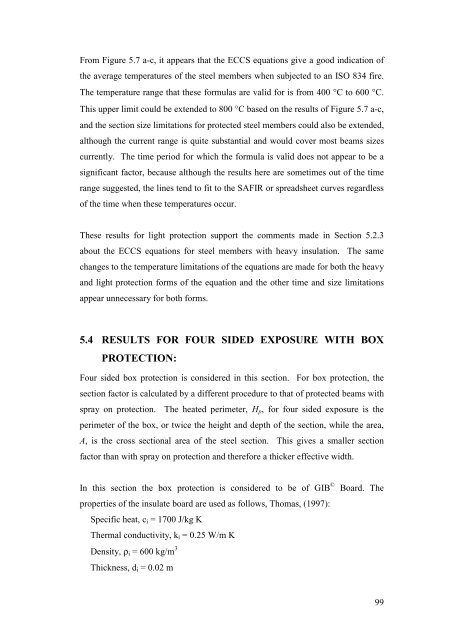FIRE DESIGN OF STEEL MEMBERS - Civil and Natural Resources ...
FIRE DESIGN OF STEEL MEMBERS - Civil and Natural Resources ...
FIRE DESIGN OF STEEL MEMBERS - Civil and Natural Resources ...
Create successful ePaper yourself
Turn your PDF publications into a flip-book with our unique Google optimized e-Paper software.
From Figure 5.7 a-c, it appears that the ECCS equations give a good indication of<br />
the average temperatures of the steel members when subjected to an ISO 834 fire.<br />
The temperature range that these formulas are valid for is from 400 °C to 600 °C.<br />
This upper limit could be extended to 800 °C based on the results of Figure 5.7 a-c,<br />
<strong>and</strong> the section size limitations for protected steel members could also be extended,<br />
although the current range is quite substantial <strong>and</strong> would cover most beams sizes<br />
currently. The time period for which the formula is valid does not appear to be a<br />
significant factor, because although the results here are sometimes out of the time<br />
range suggested, the lines tend to fit to the SAFIR or spreadsheet curves regardless<br />
of the time when these temperatures occur.<br />
These results for light protection support the comments made in Section 5.2.3<br />
about the ECCS equations for steel members with heavy insulation. The same<br />
changes to the temperature limitations of the equations are made for both the heavy<br />
<strong>and</strong> light protection forms of the equation <strong>and</strong> the other time <strong>and</strong> size limitations<br />
appear unnecessary for both forms.<br />
5.4 RESULTS FOR FOUR SIDED EXPOSURE WITH BOX<br />
PROTECTION:<br />
Four sided box protection is considered in this section. For box protection, the<br />
section factor is calculated by a different procedure to that of protected beams with<br />
spray on protection. The heated perimeter, H p , for four sided exposure is the<br />
perimeter of the box, or twice the height <strong>and</strong> depth of the section, while the area,<br />
A, is the cross sectional area of the steel section. This gives a smaller section<br />
factor than with spray on protection <strong>and</strong> therefore a thicker effective width.<br />
In this section the box protection is considered to be of GIB ©<br />
properties of the insulate board are used as follows, Thomas, (1997):<br />
Specific heat, c i = 1700 J/kg K<br />
Thermal conductivity, k i = 0.25 W/m K<br />
Density, ρ i = 600 kg/m 3<br />
Thickness, d i = 0.02 m<br />
Board. The<br />
99
















